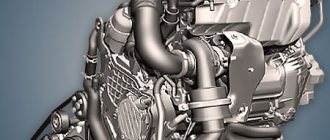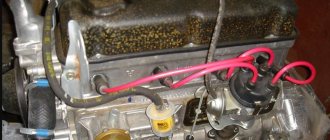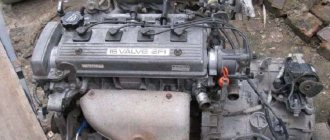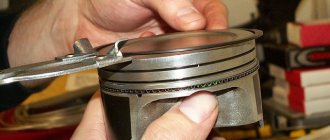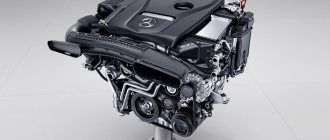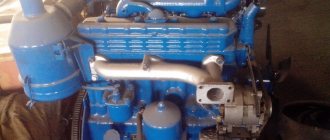Engine overview
Engine 103rd Mercedes
The new family of German units immediately received lightweight cylinder blocks (cast iron), a 12-valve cylinder head with a single camshaft and automatic valve thermal clearance regulators. The predecessor M110 used a twin-shaft 24-valve head, which was charged with increased fuel consumption, heavy weight and high production costs.
Fuel injection on M103 series engines was carried out mechanically using the KE-Jetronic type. A not very reliable single-row chain was used as a timing drive. Although it was metal, already at the 100 thousand km mark it stretched and broke off.
In 1989, the M103 engine began to be replaced by the more advanced M104 engine. Production of the 103rd was finally discontinued in 1993.
The M103 series included two units: E26 and E30. The E26 was called the little brother not only because of its smaller displacement. Even the base for it was the larger E30, released earlier. The 3-liter engine had a cylinder diameter of 88.5 mm, while the 2.6-liter engine had a 6.6 mm smaller cylinder diameter. The sizes of the intake/exhaust valves also differed. The remaining components and parts were interchangeable.
| Production | Stuttgart-Bad Cannstatt Plant |
| Engine make | M103 |
| Years of manufacture | 1985-1993 |
| Cylinder block material | cast iron |
| Supply system | injector |
| Type | in-line |
| Number of cylinders | 6 |
| Valves per cylinder | 2 |
| Piston stroke, mm | 80.2 |
| Cylinder diameter, mm | 82.9 |
| Compression ratio | 9.2 |
| Engine capacity, cc | 2599 |
| Engine power, hp/rpm | 160/5800, 166/5800 |
| Torque, Nm/rpm | 220/4600, 228/4600 |
| Fuel | 95 |
| Engine weight, kg | ~170 |
| Fuel consumption, l/100 km (for 190 E W201), city/highway/mixed | 12.4/8.2/10.2 |
| Oil consumption, g/1000 km | up to 1500 |
| Engine oil | 0W-30, 0W-40, 5W-30, 5W-40, 5W-50, 10W-40, 10W-50, 15W-40, 15W-50 |
| How much oil is in the engine, l | 6.0 |
| When replacing, pour, l | ~5.5 |
| Oil change carried out, km | 7000-10000 |
| Engine operating temperature, degrees. | ~90 |
| Engine life, thousand km | 600+ |
| What cars was it installed on? | Mercedes-Benz E-Class 190, Mercedes-Benz S-Class 260 |
Released in 1985, the inline six-cylinder M103 E30 engine was intended to replace the M110 engine, which was outdated in all respects, and was partially unified with the four-cylinder M102 2 liter. The next M103 series (which included the 2.6-liter M103 E26) received a new lightweight cylinder block made of cast iron and a 12-valve cylinder head with one camshaft and hydraulic compensators, instead of the previous 24-valve twin-shaft, which was due to the desire to increase efficiency and reduce the weight of the power plant and the costs of its production. The diameter of the intake valves is 43 mm, the exhaust valves are 39 mm. Fuel injection system - mechanical injection.
The timing drive of the M103 motor uses a not very reliable single-row chain. The engine fuel supply system is KE-Jetronic. The successor to the three-liter M103 engine, called the M104 E30, was released in 1989, but it only managed to finally displace the M103 in 1993.
M103 E30 engine modifications
- M103.980 (1985 - 1985) - the first version without a catalyst, power 188 hp. at 5700 rpm, torque 260 Nm at 4400 rpm. Compression ratio 10. Installed on Mercedes-Benz 300 E W124.
- M103.981 (1985 - 1991) - analogue of M 103.980 with a compression ratio of 9.2, produced for the Mercedes-Benz 300 SE/SEL W126. Versions without a catalyst with a power of 188 hp were produced. at 5700 rpm, torque 260 Nm at 4400 rpm and with a catalyst (CAT), the power of which is 180 hp. at 5700 rpm, torque 255 Nm at 4400 rpm.
- M103.982 (1985 - 1989) - analogue of M 103.981 for Mercedes-Benz 300 SL R107. Produced in catalytic and non-catalyst versions.
- M103.983 (1985 - 1993) - analogue of M 103.981 for Mercedes-Benz 300 E W124/E300 W124. Produced in catalytic and non-catalytic versions.
- M103.984 (1989 - 1993) - analogue of M103.981, power 190 hp. at 5700 rpm, torque 260 Nm at 4500 rpm. Installed on Mercedes-Benz 300 SL R129.
- M103.985 (1985 - 1993) - an analogue of M103.983 for the all-wheel drive Mercedes-Benz 300 E 4Matic W124.
The engine was installed on the following models:
- Mercedes-Benz 300 E W124
- Mercedes-Benz 300 SE W126
- Mercedes-Benz 300SL R107
- Mercedes-Benz 300SL R129
The younger version of the M103 series, developed and released as a replacement for the ancient M123 engine, was the M103 E26. The basis for the creation of the 2.6-liter power unit was the M103 E30, the cylinder diameter of which was reduced to 82.9 mm (88.5 mm on the base engine). The cylinder head from the M103 E30 is adapted for the E26, the diameter of the intake valves is reduced from 43 mm to 40 mm, and the exhaust valves from 39 mm to 35 mm. Fuel injection system - mechanical injection.
The timing drive uses a single-row chain that is subject to tension. Fuel supply system - KE-Jetronic. Since 1992, Mercedes began producing a successor, the next version in the development of in-line six-cylinder engines, under the name M 104 E28, which in 1993 completely took the place of its predecessor.
M103 E26 engine modifications
- M103.940 (1985 - 1992) - version for the Mercedes-Benz 260 E W124, produced in a version without a catalyst with a power of 166 hp. at 5800 rpm, torque 228 Nm at 4600 rpm and with a catalyst (CAT) 160 hp. at 5800 rpm, torque 220 Nm at 4600 rpm.
- M103.941 (1985 - 1992) - analogue of M 103.940 for Mercedes-Benz 260 SE/SEL W126.
- M103.942 (1986 - 1993) - analogue of M 103.940 for Mercedes-Benz 190 E W201.
- M103.943 (1986 - 1992) - analogue of M 103.940 for Mercedes-Benz 260 E 4Matic W124.
Problems and disadvantages of Mercedes M103 engines
- Unstable engine operation. The most common problem causing this malfunction is clogged injectors. Check, change and everything will work like clockwork.
- Oil leaks. In the M103 engine, the crankshaft seals and the U-shaped gasket of the front cover tend to leak. In addition, the timing chain is not reliable, along with the sprockets, which tend to wear out after 100-150 thousand km. Valve seals last up to 100 thousand km, which subsequently leads to high oil consumption. In addition to all this, given the age of the engine, any other malfunctions caused by natural wear and tear may occur during operation. With quiet operation, regular maintenance and the use of high-quality working fluids, the Mercedes M103 engine will last 500-600 thousand km or more.
Series 103 engine malfunctions
Let's look at the characteristic “sores” of these units.
- First of all, the headache of the owners of these engines was associated with oil leakage. The crankshaft seals and the front cover gasket (made in the shape of the letter “P”) did not last long.
- After 100,000 miles, the engine lost stability. The most common reason for this was the injectors becoming clogged and requiring cleaning and, in some cases, replacement.
- A single row timing chain is the weak link. It wore out even before the 100,000th mileage along with the sprockets.
- The oil burn was associated with wear of the valve stem seals, which required replacement before the 100,000 mileage.
Oil for Mercedes engine
As a rule, regular maintenance, filling with high-quality lubricants and a calm driving style made it possible to operate the engine for 400-500 thousand kilometers without major repairs. However, as soon as one of the points was ignored, the problems described above began.
Modifications
| Modification | Year of issue | Description |
| M103.940 | 1985 - 1992 | Version for Mercedes-Benz 260 E W124, produced in a version without a catalyst with a power of 166 hp. at 5800 rpm, torque 228 Nm at 4600 rpm and with a catalyst (CAT) 160 hp. at 5800 rpm, torque 220 Nm at 4600 rpm. |
| M103.941 | 1985 - 1992 | Analog M 103.940 for Mercedes-Benz 260 SE/SEL W126. |
| M103.942 | 1986 - 1993 | Analog M 103.940 for Mercedes-Benz 190 E W201. |
| M103.943 | 1986 - 1992 | Analog M 103.940 for Mercedes-Benz 260 E 4Matic W124. |
| M103.980 | 1985 - 1985 | The first version without a catalyst, power 188 hp. at 5700 rpm, torque 260 Nm at 4400 rpm. Compression ratio 10. Installed on Mercedes-Benz 300 E W124. |
| M103.981 | 1985 - 1991 | An analogue of M 103.980 with a compression ratio of 9.2, produced for the Mercedes-Benz 300 SE/SEL W126. Versions without a catalyst with a power of 188 hp were produced. at 5700 rpm, torque 260 Nm at 4400 rpm and with a catalyst (CAT), the power of which is 180 hp. at 5700 rpm, torque 255 Nm at 4400 rpm. |
| M103.982 | 1985 - 1989 | Analog M 103.981 for Mercedes-Benz 300 SL R107. Produced in catalytic and non-catalyst versions. |
| M103.983 | 1985 - 1993 | Analogue of M 103.981 for Mercedes-Benz 300 E W124/E300 W124. Produced in catalytic and non-catalytic versions. |
| M103.984 | 1989 - 1993 | Analogue M103.981, power 190 hp. at 5700 rpm, torque 260 Nm at 4500 rpm. Installed on Mercedes-Benz 300 SL R129. |
| M103.985 | 1985 - 1993 | Analog M103.983 for all-wheel drive Mercedes-Benz 300 E 4Matic W124. |
Characteristics and features of motors
The Mercedes M103 3.0 engine had a full-fledged injector from the very beginning of production. This power unit was replaced by the M104 with improved design characteristics.
Mercedes M103 3.0.
The in-line six-cylinder M103 E30 engine, released in 1985, was intended to replace the M110 engine, which was outdated in all respects, and was partially unified with the four-cylinder M102 2 liter.
The next 103 series (which included the 2.6-liter M103 E26) received a new lightweight cylinder block made of cast iron and a 12-valve cylinder head with one camshaft and hydraulic compensators, instead of the previous 24-valve twin-shaft, which was caused by the desire to increase efficiency and reduce weight power plant and the costs of its production.
The diameter of the intake valves is 43 mm, exhaust valves 39 mm. Fuel injection system - mechanical injection. The timing drive uses a not very reliable single-row chain. Fuel supply system - KE-Jetronic.
Engine Mercedes M103 3.0.
M103 E26
| Name | Characteristics |
| Manufacturer | Stuttgart-Bad Cannstatt Plant |
| Motor brand | M103 |
| engine's type | Injector |
| Volume | 3.0 liters (2962 cm3) |
| Power | 180-190 hp |
| Cylinder diameter | 88.5 |
| Number of cylinders | 6 |
| Number of valves | 12 |
| Compression ratio | 9.2-10 |
| Fuel consumption | 14.5 liters for every 100 km in mixed mode |
| Engine oil | 0W-30 0W-40 5W-30 5W-40 5W-50 10W-40 10W-50 15W-40 15W-50 |
| Resource | 400+ thousand km |
Motor modifications
Over the long period of production of the power unit, a significant number of engine modifications were produced, which became widespread. Let's consider what varieties the M103 E30 engine has:
- M103.980 (1985 - 1985 onwards) - the first version without a catalyst, power 188 hp. at 5700 rpm, torque 260 Nm at 4400 rpm. Compression ratio 10. Installed on Mercedes-Benz 300 E W124.
- M103.981 (1985 - 1991) - analogue of M 103.980 with a compression ratio of 9.2, produced for the Mercedes-Benz 300 SE/SEL W126. Versions without a catalyst with a power of 188 hp were produced. at 5700 rpm, torque 260 Nm at 4400 rpm and with a catalyst (CAT), power of 180 hp. at 5700 rpm, torque 255 Nm at 4400 rpm.
- M103.982 (1985 - 1989) - analogue of M 103.981 for Mercedes-Benz 300 SL R107. Produced in catalytic and non-catalyst versions.
- M103.983 (1985 - 1993) - analogue of M 103.981 for Mercedes-Benz 300 E W124/E300 W124. Produced in catalytic and non-catalyst versions.
- M103.984 (1989 - 1993) - analogue of M103.981, power 190 hp. at 5700 rpm, torque 260 Nm at 4500 rpm. Installed on Mercedes-Benz 300 SL R129.
- M103.985 (1985 - 1993) - analogue of M103.983 for all-wheel drive Mercedes-Benz 300 E 4Matic W124.
Tuning options
Modifications to the M103 are rarely carried out using sports camshafts. It is very expensive, and the effect is zero. You have to use either supercharging or do a swap on the 104th. The latter initially has more power, and its components are much more technologically advanced.
Those wishing to carry out a turbo modernization should know that the ideal option would be to install the Eaton M45 compressor from M111.981. — this turbine is very productive. You should also add 300 cc injectors, a Valbro 255 pump, an intercooler and reflash the brains.
Engine M111
| Simon | There is a 103rd engine. They advised not to take this Merc because of the 103rd engine, but nothing has been done yet and there are no hints of repairs. The only problem is that the oil pressure is at “0” at idle! I will fix this problem. Regarding gasoline consumption: I drive on 92 gasoline. If you don’t heat it (40-60), then you can safely keep it to 13, I prefer a more active driving style, my consumption is about 16 (60-100), this is in the city. On the highway it's about 9-10 at a speed of 130-150. |
| Vasik | If you take it, then take 2.6 or 3.0! If you do it, don’t be afraid; if you’re afraid, don’t do it! |
| Ararat | Add thicker oil |
| MTS | How is this pressure zero at XX??? It is not normal. Minimum acceptable limit is +/-0.75. This problem needs to be dealt with quickly. |
| Simon | Today I was told that it could be the oil pressure sensor being stuck or possibly due to the SCT filter |
| Mbb | The 103 engine is actually not bad, it can easily go 500,000 without major overhauls, but it is very afraid of overheating due to clogged radiators (a problem with all in-line sixes) and constant oil leaks (practically untreatable). The pressure gauge may be faulty (at 0 the pressure lamp is on)! and also look at the dipstick to see if there is any coolant in the oil (in case of overheating (even if it’s not yours), you could get a headache and the coolant gets into the oil! Gasoline is unlikely because it evaporates quickly! and the oil takes a long time to liquefy! |
| Simon | The oil is in perfect order!!! there is no visible presence of gasoline or coolant! There are plans to cut out the catalyst, people have different opinions about this!!! I would like to hear yours! |
| Experienced | As for the catalyst, I will say that if it is clogged (which is most likely), then it creates excess pressure at the outlet, which leads to a noticeable decrease in power, and here (if you don’t feel sorry for nature) it is quite possible to install flame extinguishers in cars from the 80-90s with one lambda ( stands in front of the catalyst) the probe allows you to do this without reprogramming the brain (modern cars with 2 catalysts simply won’t allow you to do this without reprogramming) |
| Socrates | I would like to know more about the catalyst. I have a 102 engine. there is also a catalyst. What are the pros and cons of not having it? Thank you! |
| Brother79 | The advice is normal (for Slavs)! Verified for us. Fact. If the catalyst is clogged - ok. The engine will be of no use!!! No matter how you regulate it. Wasted money and time No.No.No.No., until a normal person took the exhaust down to his pants... Fuck you... ate. Rushing, s..ka how... (Tested on 2 cars) In ecstasy, I was driving along the country roads (I know it’s bad (Roar, and all that, But!!(((But THE DIFFERENCE) And s..ka is inexpensive... uh THAT passed for "money". I doubt the environmental friendliness of the exhaust. (although they guaranteed that with the No. settings - everything is possible) - I didn’t bother with the calculation. Buying a catalyst - if it presses, I’ll buy it. The probe is located before the catalyst and does not affect its operation (except how it increases the pressure of exhaust gases in the exhaust system, which in turn significantly affects the operation of the engine. Therefore, brother, IMHO - smash the hole in the catalyst with all your might (or change it the hell out of a homemade art) for free exhaust and drive on health (before the green ones - ecologists. Although... There were cases, frequent - not a fact! - it dropped???!!! This is in Ukraine). The program of the "brains" of the car probably does not affect the problems with the throughput of the catalyst (as part exhaust system), although..... |
| Pasha | I had a 124 with a 102 engine (2.3) with a mileage of 360 thousand. There were no problems, I invested about 10 thousand rubles in a year, and drove it every day. Moreover, there were only two modes of operation of the gas pedal - on and off... I didn’t add oil from replacement to replacement... it lost 500 grams, from maximum to middle. About the pressure - when you stand in a traffic jam for an hour, it shows 1, but 2.5 is stable... so look at the sensor. If it were 0, then the pressure lamp would be on... I think it should light up at 0.75. |
| Socrates | I have a w201 102 2.3 engine. The minimum permissible pressure is 0.3 bar according to the documentation. The pressure somehow dropped in winter to 0.9. I went to the master. Checked the sensor, everything is ok. The oil pump may be worn out. There is also a drop in pressure when the dispenser becomes clogged. And gasoline enters the crankcase. This causes the pressure to drop. If I'm not mistaken, the 103 engine has mechanical injection, just like the 102 engine. I cleaned the fuel system because the dispenser was clogged. Because of this, the oil was filled with gasoline. The oil level was higher than normal. After cleaning, the oil level remains the same. But the pressure never appeared. When changing the oil, for some reason only 4 liters fit into the engine. Previously it was always 4.5. Maybe there is old oil and gasoline left and that’s why I have no pressure. I'll check after changing the oil. |

